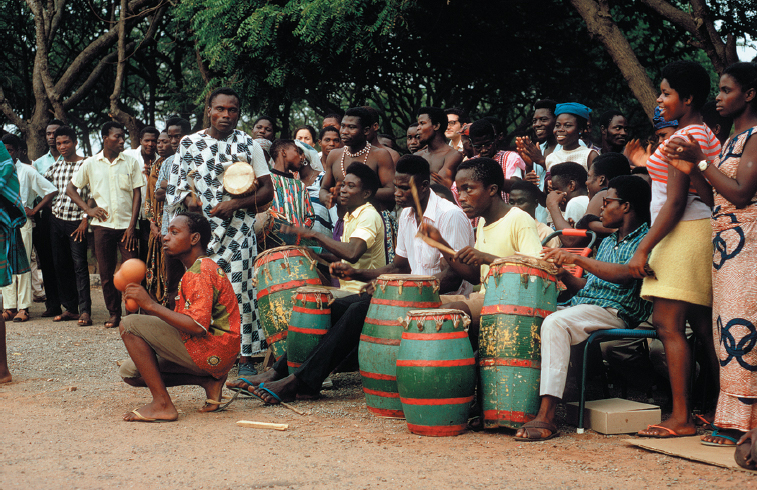Global Perspectives: African Drumming
African Drumming

The syncopated rhythms of ragtime, blues, and jazz derived from traditional African music, particularly drumming. Listen now to a recording of a drum ensemble from Benin, a small West African nation situated between Ghana and Nigeria. The drummers play music used in the worship of ancestral spirits among the Yoruba people — one of a wide variety of religious and nonreligious uses of drumming in the region.
Syncopation and Polyrhythms
The rhythms of this music cannot be said to swing precisely in the manner of jazz, but they show a complexity and vitality related to jazz rhythms and not native to the European classical music tradition.
These rhythms are related to what we have termed beat syncopation in jazz (see page 386). A single drum lays down a basic, fast, four-
Against the main drum’s consistent pulse, the other drums play a variety of different rhythms. Sometimes they underscore the main drum’s even pulse, or even duplicate it. Often, however, they play off it with more complicated and varied rhythms, including extensive syncopation within the groups of four (or beats), and occasionally they boldly contradict it.
Such overlapping of varied patterns with the main pulse is essential in West African drumming. Since several rhythmic formulas can be heard at once, it is sometimes called polyrhythm. Here are the details of a few clear polyrhythmic interactions:
- One drummer aligns a regular syncopated formula against the main pulse, in this manner:

Listen for this four times in the recording, at 0:23–
0:29, 0:50– 0:53, 1:23– 1:28, and 2:13– 2:20. - Another drummer plays an even three-
plus- three pulse against the main four- plus- four, seeming to contradict its duple meter with a triple orientation. This occurs prominently twice, at 0:41– 0:44 and again at 2:22– 2:26. - One drummer in particular departs freely from the main pulse all the way through this recording. He is the soloist, so to speak, improvising against the more regular and predictable playing of his ensemble mates. His drum is recognizable by its wooden, clickety-
clack timbre and by the fact that it plays two distinct pitches (the higher pitch is more wooden- sounding than the lower).
